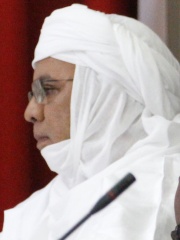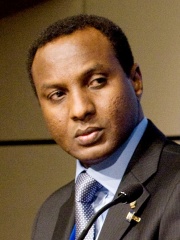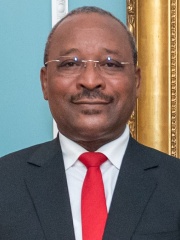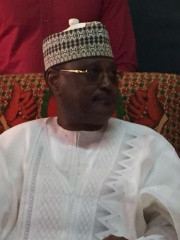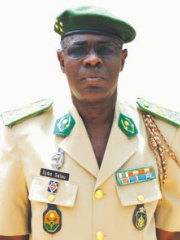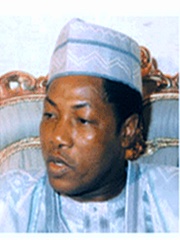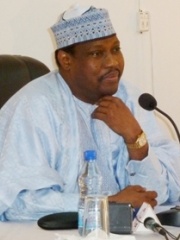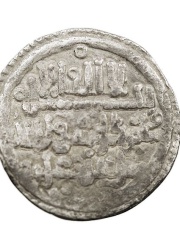
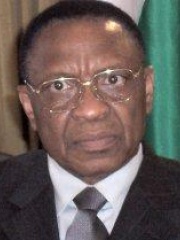
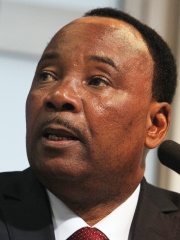
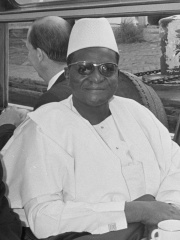
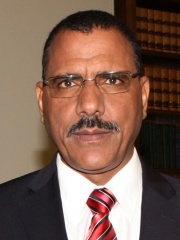
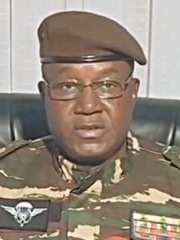
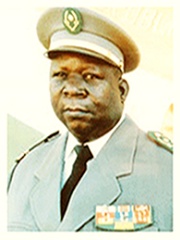
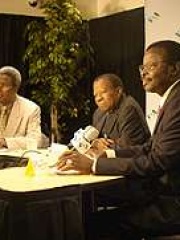
The Most Famous
POLITICIANS from Niger
This page contains a list of the greatest Nigerien Politicians. The pantheon dataset contains 19,576 Politicians, 17 of which were born in Niger. This makes Niger the birth place of the 121st most number of Politicians behind Sudan, and Nicaragua.
Top 10
The following people are considered by Pantheon to be the top 10 most legendary Nigerien Politicians of all time. This list of famous Nigerien Politicians is sorted by HPI (Historical Popularity Index), a metric that aggregates information on a biography's online popularity. Visit the rankings page to view the entire list of Nigerien Politicians.

1. Yusuf ibn Tashfin (1009 - 1106)
With an HPI of 70.94, Yusuf ibn Tashfin is the most famous Nigerien Politician. His biography has been translated into 40 different languages on wikipedia.
Yusuf ibn Tashfin, also Tashafin, Teshufin, (Arabic: يوسف بن تاشفين ناصر الدين بن تالاكاكين الصنهاجي, romanized: Yūsuf ibn Tāshfīn Naṣr al-Dīn ibn Tālākakīn al-Ṣanhājī; reigned c. 1061 – 1106) was a Sanhaja leader of the Almoravid Empire. He cofounded the city of Marrakesh and led the Muslim forces in the Battle of Sagrajas. Yusuf ibn Tashfin came to al-Andalus from the Maghreb to help the Muslims fight against Alfonso VI of León, eventually achieving victory in Sagrajas and promoting an Islamic legal system in the region. In 1061 he took the title Amir al-Muslimin "Leader of the Muslims", recognizing the suzerainty of the Abbasid caliph as Amir al-Mu'minin "Leader of the Believers".

2. Mamadou Tandja (1938 - 2020)
With an HPI of 66.90, Mamadou Tandja is the 2nd most famous Nigerien Politician. His biography has been translated into 42 different languages.
Mamadou Tandja (1938 – 24 November 2020) was a Nigerien politician who was President of Niger from 1999 to 2010. He was President of the National Movement for the Development of Society (MNSD) from 1991 to 1999 and unsuccessfully ran as the MNSD's presidential candidate in 1993 and 1996 before being elected to his first term in 1999. While serving as President of Niger, he was also Chairman of the Economic Community of West African States from 2005 to 2007. Tandja was of mixed Fula and Soninke ethnicity. He was the first President of Niger who was not ethnically Hausa or Djerma. Following a constitutional crisis in 2009, which was caused by Tandja's efforts to remain in office beyond his term, he was ousted by the military in a coup d'état on 18 February 2010.

3. Mahamadou Issoufou (b. 1952)
With an HPI of 65.25, Mahamadou Issoufou is the 3rd most famous Nigerien Politician. His biography has been translated into 55 different languages.
Mahamadou Issoufou (born 1 January 1952) is a Nigerien politician who served as the president of Niger from 7 April 2011 to 2 April 2021. Issoufou was the prime minister of Niger from 1993 to 1994, president of the National Assembly from 1995 to 1996, and a candidate in each presidential election from 1993 to 2016. He led the Nigerien Party for Democracy and Socialism (PNDS-Tarayya), a social democratic party, from its foundation in 1990 until his election as president in 2011. During the presidency of Mamadou Tandja (1999–2010), Issoufou was the main opposition leader. Having left power by respecting the constitution that limited him to two presidential terms, thus leading to the first ever democratic transition of power in the country, in March 2021 he received the Ibrahim Prize for good governance, democratic election and respect of term limits.

4. Hamani Diori (1916 - 1989)
With an HPI of 64.48, Hamani Diori is the 4th most famous Nigerien Politician. His biography has been translated into 35 different languages.
Hamani Diori (6 June 1916 – 23 April 1989) was the first President of the Republic of Niger. He was appointed to that office in 1960, when Niger gained independence from France. Although corruption was a common feature of his administration, he gained international respect for his role as a spokesman for African affairs and as a popular arbitrator in conflicts. His rule ended with a military coup in 1974.
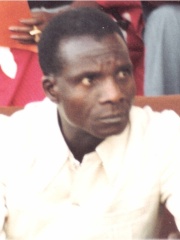
5. Seyni Kountché (1931 - 1987)
With an HPI of 63.15, Seyni Kountché is the 5th most famous Nigerien Politician. His biography has been translated into 31 different languages.
Seyni Kountché (1 July 1931 – 10 November 1987) was a Nigerien military officer who led a 1974 coup d'état that deposed the government of Niger's first president, Hamani Diori. He ruled the country as military head of state from 15 April 1974 until his death on 10 November 1987. Stade Général Seyni Kountché, Niger's national stadium in Niamey, is named after him.

6. Mohamed Bazoum (b. 1960)
With an HPI of 62.09, Mohamed Bazoum is the 6th most famous Nigerien Politician. His biography has been translated into 45 different languages.
Mohamed Bazoum (Arabic: محمد بازوم, romanized: Muḥammad Bāzūm; born 1 January 1960) is a Nigerien politician who served as the 10th president of Niger from 2021 to 2023. He assumed office in April 2021 after winning the 2020–21 presidential election and surviving a coup d'état attempt. He was ousted in the 2023 Nigerien coup d'état by members of the presidential guard and the armed forces led by Abdourahamane Tchiani. Before becoming president, he served as the president of the Nigerien Party for Democracy and Socialism (PNDS-Tarayya). He also served in as a minister of Foreign Affairs from 1995 to 1996 and again from 2011 to 2016. He was minister of State at the Presidency briefly in 2016 and was later appointed minister of State for the Interior between 2016 until his election as president in 2021, when he resigned to focus on running for the 2020–21 presidential election. Bazoum won the second round of the presidential election with 55.67% of the vote against former president Mahamane Ousmane. Bazoum, a member of the Arab minority Ouled Slimane people, is the first Arab president of Niger in the country's history.

7. Abdourahamane Tchiani (b. 1961)
With an HPI of 61.51, Abdourahamane Tchiani is the 7th most famous Nigerien Politician. His biography has been translated into 35 different languages.
Abdourahamane Tchiani (Arabic: عبد الرحمن تشياني, romanized: ‘Abd ar-Rahman Tshiyānī; born 1961) is a Nigerien military officer who has served as the 11th president of Niger since 2025 and the president of the National Council for the Safeguard of the Homeland, the military junta of Niger, since 2023. Having previously served as the Chief of the Nigerien Presidential guard (2011–2023), he played a key role in the 2023 coup d'état by detaining President Mohamed Bazoum. His coup triggered the Nigerien crisis, which ended in 2024.

8. Ali Saibou (1940 - 2011)
With an HPI of 61.21, Ali Saibou is the 8th most famous Nigerien Politician. His biography has been translated into 26 different languages.
Ali Saibou (17 June 1940 – 31 October 2011) was the third President of Niger from 1987 to 1993 succeeding the deceased military ruler Seyni Kountché. A member of the Djerma people, he was born in Dingajibanda, a village in the Ouallam arrondissement. Although from Kountché's home village, Saibou is not a cousin. He became interested in a military career early on, and attended the Saint-Louis preparatory school in Senegal from 1954, then joined the First Senegalese Tirailleurs Regiment. He saw action in Cameroon in 1960, and was wounded there while with the 5th Overseas Interarms Regiment (RIOM) of France. Upon Niger's independence in 1960, Saibou was transferred to the new Niger Army as a sergeant in August 1961. He attended officers' school, and in 1969 was put in command of a unit at N'Guigmi. After moving to a new unit in Agadez in 1973, he attained the rank of captain. Saibou threw in his lot with Kountché in the coup of April 1974, and brought his troops from Agadez to Niamey. As a reward he was promoted to major, appointed to the cabinet as minister of rural economy and the environment, and on 20 November 1974, made chief of staff. However, Kountché was suspicious of Saibou. In June 1975, he dismissed Saibou from the cabinet and asked him to relinquish his command of the armed forces. Saibou countered by asking to be retired from the service altogether, an act which apparently allayed Kountché's fears. Saibou remained loyal until Kountché's death, which occurred on 10 November 1987. Saibou then secured his nomination by the Supreme Military Council as Kountché's successor, subsequently sending military rivals overseas with diplomatic tasks. In 1989, he had a new constitution approved, and founded the National Movement for the Development of Society (MNSD) as the sole legal party. As the president of the NMSD, Saibou was the only candidate for president in December. The NMSD swept all 93 seats in the National Assembly. In early 1990, unrest by students and a Tuareg assault on Tchintabaraden led to a National Conference of 1991 that ultimately dismantled one-party rule, leaving Saibou mostly ineffective. At an MNSD party congress in March 1991, Saibou was able to retain his position as party leader, particularly benefiting from the support of the army. However, later in the year the National Conference barred Saibou from running in the planned presidential election, and at another MNSD congress in November 1991 he was replaced as party leader by Mamadou Tandja. After the election of Mahamane Ousmane as president in March 1993, Saibou handed the presidency over to Mahamane on April 16—the first time that the incumbent president peacefully handed over power to the opposition—and retired to his home village. Ali Saibou died on 31 October 2011.

9. Mahamane Ousmane (b. 1948)
With an HPI of 61.19, Mahamane Ousmane is the 9th most famous Nigerien Politician. His biography has been translated into 33 different languages.
Mahamane Ousmane (born 20 January 1950) is a Nigerien politician. Elected as the fourth President of Niger at 43 years old, he is the youngest elected president in Africa. He was also the first democratically elected president of his country, serving from 16 April 1993 until he was deposed in a military coup d'état on 27 January 1996. He has continued to run for president in each election since his ouster, and he was president of the National Assembly from December 1999 to May 2009. Since April 2020, he is the president of the Democratic and Republican Renewal (RDR Tchanji), a major political party that is currently in opposition. RDR Tchanji formed an alliance with Ousmane's other political vehicle, MNRD Hankuri, on 16 December 2018.
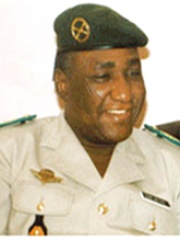
10. Daouda Malam Wanké (1946 - 2004)
With an HPI of 59.22, Daouda Malam Wanké is the 10th most famous Nigerien Politician. His biography has been translated into 28 different languages.
Daouda Malam Wanké (May 6, 1946 – September 15, 2004) was a military and political leader in Niger. He was a member of the Hausa ethnic group. Wanké's year of birth is disputed. Many sources claim it is 1954 while others suggest 1946. He held many other offices.
People
Pantheon has 17 people classified as Nigerien politicians born between 1009 and 1965. Of these 17, 9 (52.94%) of them are still alive today. The most famous living Nigerien politicians include Mahamadou Issoufou, Mohamed Bazoum, and Abdourahamane Tchiani. The most famous deceased Nigerien politicians include Yusuf ibn Tashfin, Mamadou Tandja, and Hamani Diori.
Living Nigerien Politicians
Go to all RankingsMahamadou Issoufou
1952 - Present
HPI: 65.25
Mohamed Bazoum
1960 - Present
HPI: 62.09
Abdourahamane Tchiani
1961 - Present
HPI: 61.51
Mahamane Ousmane
1948 - Present
HPI: 61.19
Brigi Rafini
1953 - Present
HPI: 59.11
Ali Lamine Zeine
1965 - Present
HPI: 54.10
Hassoumi Massaoudou
1957 - Present
HPI: 54.04
Seyni Oumarou
1951 - Present
HPI: 53.59
Salou Djibo
1965 - Present
HPI: 52.39
Deceased Nigerien Politicians
Go to all RankingsYusuf ibn Tashfin
1009 - 1106
HPI: 70.94
Mamadou Tandja
1938 - 2020
HPI: 66.90
Hamani Diori
1916 - 1989
HPI: 64.48
Seyni Kountché
1931 - 1987
HPI: 63.15
Ali Saibou
1940 - 2011
HPI: 61.21
Daouda Malam Wanké
1946 - 2004
HPI: 59.22
Ibrahim Baré Maïnassara
1949 - 1999
HPI: 58.80
Hama Amadou
1950 - 2024
HPI: 55.83
Overlapping Lives
Which Politicians were alive at the same time? This visualization shows the lifespans of the 7 most globally memorable Politicians since 1700.

